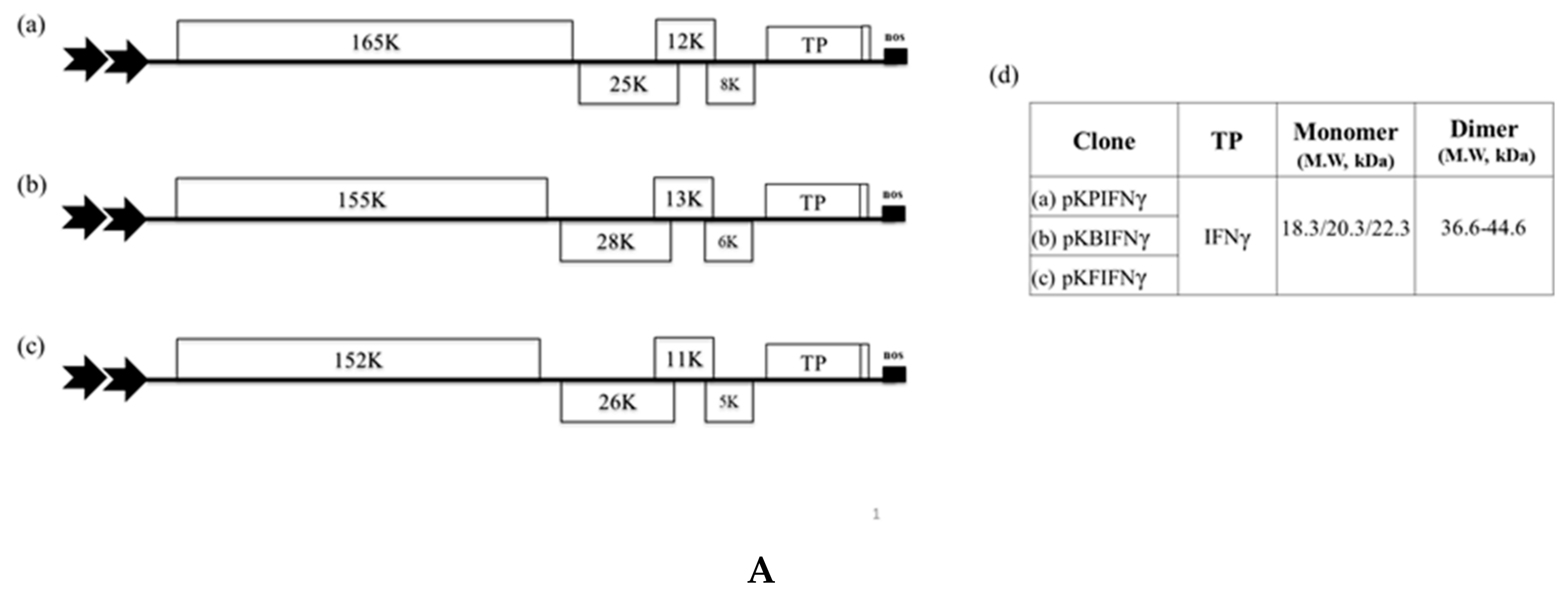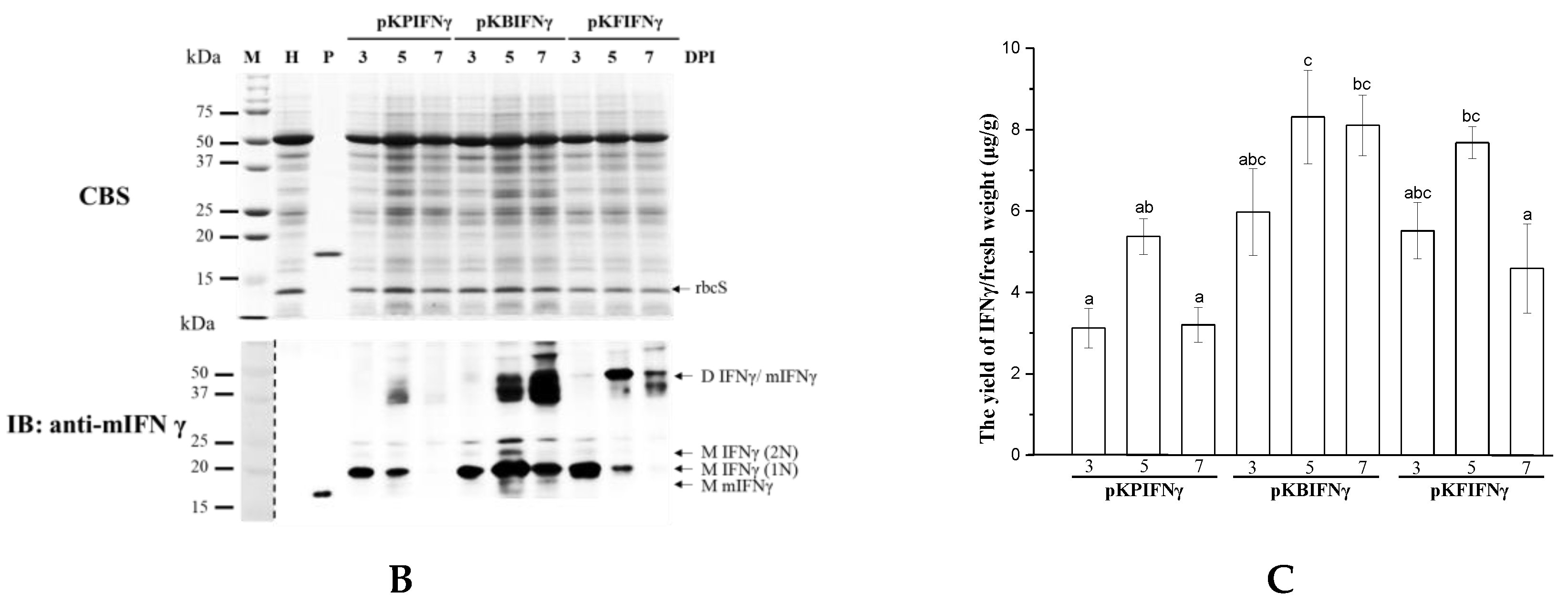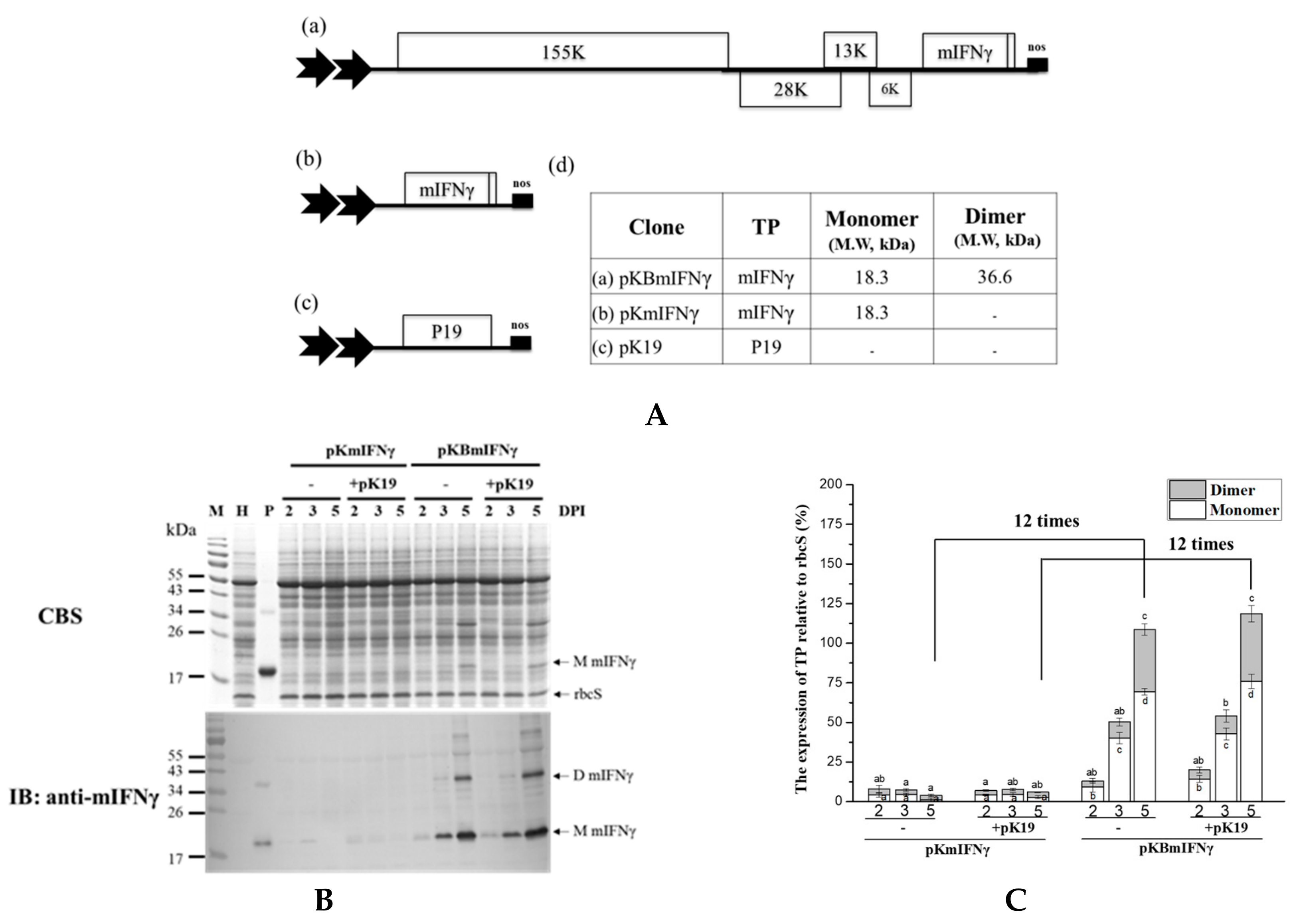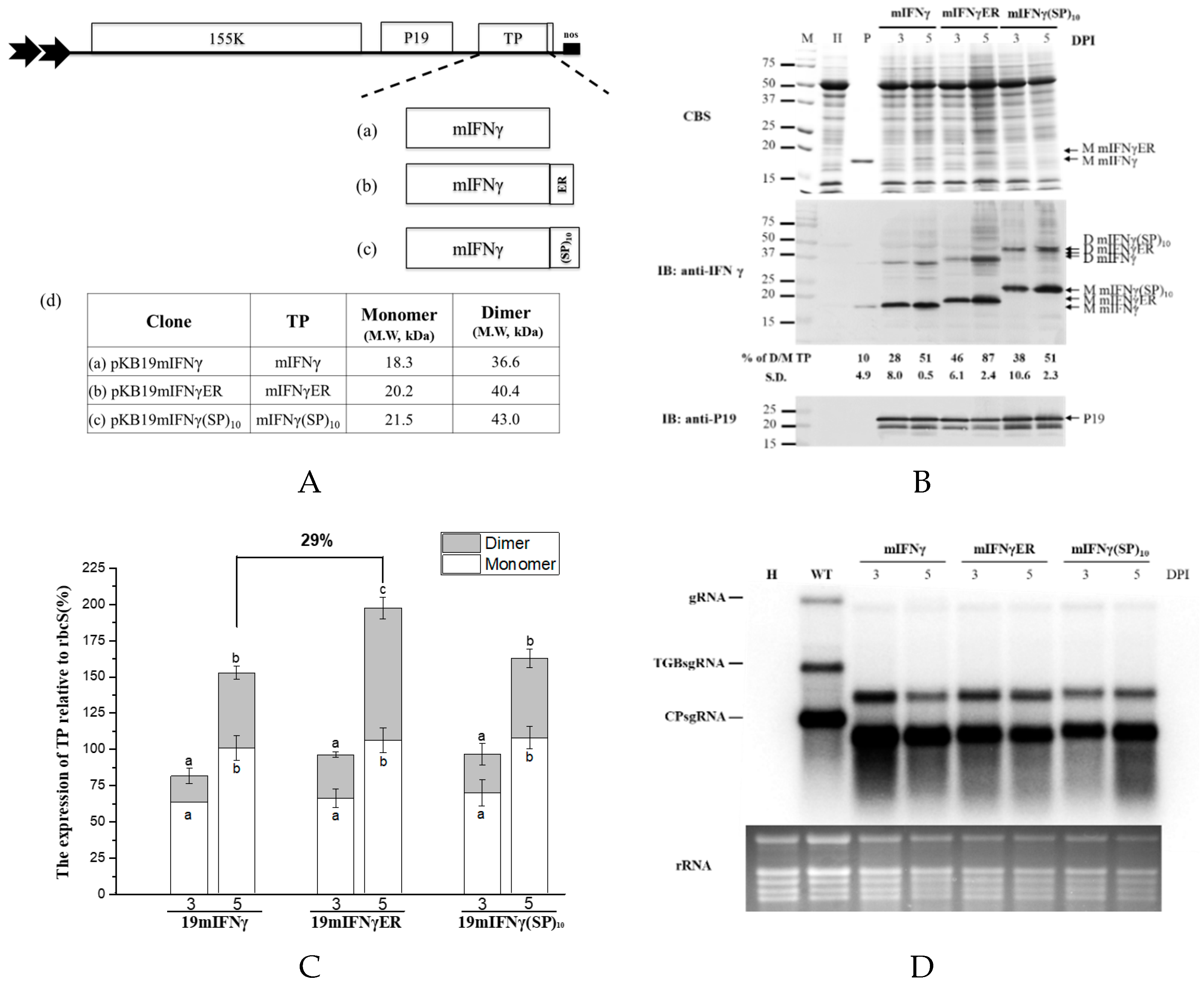Production of Human IFNγ Protein in Nicotiana benthamiana Plant through an Enhanced Expression System Based on Bamboo mosaic Virus
Abstract
1. Introduction
2. Materials and Methods
2.1. Constructions
2.2. Transient Expression of TP in N. benthamiana Plants
2.3. Immunoblotting Assay
2.4. Northern Blot Analysis
2.5. Quantitative ELISA
2.6. Statistical Analysis
3. Results
3.1. Construction of Chimeric BaMV Expression Cassettes
3.2. Effect of Different CP-Deficient Potexvirus-Based Vectors on Yields of IFNγ
3.3. Effect of N-Terminal Truncation and Codon Optimization of IFNγ
3.4. Effect of Viral Silencing Suppressors
3.5. Effect of Fusing ER Retention
4. Discussion
5. Conclusions
Supplementary Materials
Author Contributions
Funding
Acknowledgments
Conflicts of Interest
References
- Daniell, H.; Streatfield, S.J.; Wycoff, K. Medical molecular farming: production of antibodies, biopharmaceuticals and edible vaccines in plants. Trends Plant Sci. 2001, 6, 219–226. [Google Scholar] [CrossRef]
- Ma, J.K.; Drake, P.M.; Christou, P. Genetic modification: the production of recombinant pharmaceutical proteins in plants. Nat. Rev. Genet. 2003, 4, 794. [Google Scholar] [CrossRef] [PubMed]
- Tschofen, M.; Knopp, D.; Hood, E.; Stöger, E. Plant molecular farming: much more than medicines. Annu. Rev. Anal. Chem. 2016, 9, 271–294. [Google Scholar] [CrossRef] [PubMed]
- Merlin, M.; Gecchele, E.; Capaldi, S.; Pezzotti, M.; Avesani, L. Comparative evaluation of recombinant protein production in different biofactories: the green perspective. Biomed Res. Int. 2014, 2014. [Google Scholar] [CrossRef]
- Buyel, J. Plants as sources of natural and recombinant anti-cancer agents. Biotechnol. Adv. 2018, 36, 506–520. [Google Scholar]
- Baeshen, N.A.; Baeshen, M.N.; Sheikh, A.; Bora, R.S.; Ahmed, M.M.M.; Ramadan, H.A.; Saini, K.S.; Redwan, E.M. Cell factories for insulin production. Microb. Cell Factories 2014, 13, 141. [Google Scholar] [CrossRef] [PubMed]
- Marsian, J.; Lomonossoff, G.P. Molecular pharming—VLPs made in plants. Curr. Opin. Biotechnol. 2016, 37, 201–206. [Google Scholar] [CrossRef] [PubMed]
- Yao, J.; Weng, Y.; Dickey, A.; Wang, K. Plants as factories for human pharmaceuticals: applications and challenges. Int. J. Mol. Sci. 2015, 16, 28549–28565. [Google Scholar]
- Margolin, E.; Chapman, R.; Williamson, A.L.; Rybicki, E.P.; Meyers, A.E. Production of complex viral glycoproteins in plants as vaccine immunogens. Plant Biotechnol. J. 2018, 16, 1531–1545. [Google Scholar] [CrossRef] [PubMed]
- Abiri, R.; Valdiani, A.; Maziah, M.; Shaharuddin, N.A.; Sahebi, M.; Yusof, Z.N.B.; Atabaki, N.; Talei, D. A critical review of the concept of transgenic plants: insights into pharmaceutical biotechnology and molecular farming. Curr. Issues Mol. Biol. 2015, 18, 21–42. [Google Scholar]
- Gleba, Y.; Klimyuk, V.; Marillonnet, S. Viral vectors for the expression of proteins in plants. Curr. Opin. Biotechnol. 2007, 18, 134–141. [Google Scholar] [CrossRef] [PubMed]
- Gleba, Y.Y.; Tusé, D.; Giritch, A. Plant viral vectors for delivery by Agrobacterium. In Plant Viral Vectors; Springer: New York, NY, USA, 2013; pp. 155–192. [Google Scholar]
- Hefferon, K. Plant virus expression vectors: a powerhouse for global health. Biomedicines 2017, 5, 44. [Google Scholar] [CrossRef] [PubMed]
- Daniell, H.; Singh, N.D.; Mason, H.; Streatfield, S.J. Plant-made vaccine antigens and biopharmaceuticals. Trends Plant Sci. 2009, 14, 669–679. [Google Scholar] [CrossRef] [PubMed]
- Hefferon, K.L. Plant virus expression vectors set the stage as production platforms for biopharmaceutical proteins. Virology 2012, 433, 1–6. [Google Scholar] [CrossRef] [PubMed]
- Hefferon, K. Plant virus expression vector development: new perspectives. Biomed Res. Int. 2014, 2014. [Google Scholar] [CrossRef]
- Plchova, H.; Cerovska, N.; Vaculik, P.; Moravec, T. Plant viruses as scaffolds for the presentation of vaccine epitopes. Biol. Plant. 2017, 61, 1–12. [Google Scholar] [CrossRef]
- Baron, S.; Tyring, S.K.; Fleischmann, W.R.; Coppenhaver, D.H.; Niesel, D.W.; Klimpel, G.R.; Stanton, G.J.; Hughes, T.K. The interferons: mechanisms of action and clinical applications. JAMA 1991, 266, 1375–1383. [Google Scholar] [CrossRef]
- Schroder, K.; Hertzog, P.J.; Ravasi, T.; Hume, D.A. Interferon-γ: an overview of signals, mechanisms and functions. J. Leukoc. Biol. 2004, 75, 163–189. [Google Scholar] [CrossRef]
- Zlateva, T.; Boteva, R.; Salvato, B.; Tsanev, R. Factors affecting the dissociation and aggregation of human interferon gamma. Int. J. Biol. Macromol. 1999, 26, 357–362. [Google Scholar] [CrossRef]
- Sareneva, T.; Pirhonen, J.; Cantell, K.; Kalkkinen, N.; Julkunen, I. Role of N-glycosylation in the synthesis, dimerization and secretion of human interferon-γ. Biochem. J. 1994, 303, 831–840. [Google Scholar] [CrossRef]
- Sareneva, T.; Pirhonen, J.; Cantell, K.; Julkunen, I. N-glycosylation of human interferon-γ: glycans at Asn-25 are critical for protease resistance. Biochem. J. 1995, 308, 9–14. [Google Scholar] [CrossRef] [PubMed]
- Reddy, P.K.; Reddy, S.G.; Narala, V.R.; Majee, S.S.; Konda, S.; Gunwar, S.; Reddy, R.C. Increased yield of high purity recombinant human interferon-γ utilizing reversed phase column chromatography. Protein Expr. Purif. 2007, 52, 123–130. [Google Scholar] [CrossRef]
- Yan, X.; Hu, S.; Guan, Y.-X.; Yao, S.-J. Coexpression of chaperonin GroEL/GroES markedly enhanced soluble and functional expression of recombinant human interferon-gamma in Escherichia coli. Appl. Microbiol. Biotechnol. 2012, 93, 1065–1074. [Google Scholar] [CrossRef]
- Wang, D.; Ren, H.; Xu, J.-W.; Sun, P.-D.; Fang, X.-D. Expression, purification and characterization of human interferon-γ in Pichia pastoris. Mol. Med. Rep. 2014, 9, 715–719. [Google Scholar] [CrossRef] [PubMed][Green Version]
- Chen, W.-S.; Villaflores, O.B.; Jinn, T.-R.; Chan, M.-T.; Chang, Y.-C.; Wu, T.-Y. Expression of recombinant human interferon-γ with antiviral activity in the bi-cistronic baculovirus-insect/larval system. Biosci. Biotechnol. Biochem. 2011, 75, 1342–1348. [Google Scholar] [CrossRef] [PubMed][Green Version]
- Liou, M.R.; Huang, Y.W.; Hu, C.C.; Lin, N.S.; Hsu, Y.H. A dual gene-silencing vector system for monocot and dicot plants. Plant Biotechnol. J. 2014, 12, 330–343. [Google Scholar] [CrossRef]
- Yang, C.-D.; Liao, J.-T.; Lai, C.-Y.; Jong, M.-H.; Liang, C.-M.; Lin, Y.-L.; Lin, N.-S.; Hsu, Y.-H.; Liang, S.-M. Induction of protective immunity in swine by recombinant bamboo mosaic virus expressing foot-and-mouth disease virus epitopes. BMC Biotechnol. 2007, 7, 1. [Google Scholar] [CrossRef]
- Chen, T.-H.; Chen, T.-H.; Hu, C.-C.; Liao, J.-T.; Lee, C.-W.; Liao, J.-W.; Lin, M.-Y.; Liu, H.-J.; Wang, M.-Y.; Lin, N.-S. Induction of protective immunity in chickens immunized with plant-made chimeric bamboo mosaic virus particles expressing very virulent infectious bursal disease virus antigen. Virus Res. 2012, 166, 109–115. [Google Scholar] [CrossRef]
- Chen, T.-H.; Hu, C.-C.; Liao, J.-T.; Lee, Y.-L.; Huang, Y.-W.; Lin, N.-S.; Lin, Y.-L.; Hsu, Y.-H. Production of Japanese encephalitis virus antigens in plants using bamboo mosaic virus-based vector. Front. Microbiol. 2017, 8, 788. [Google Scholar] [CrossRef]
- Muthamilselvan, T.; Lee, C.W.; Cho, Y.H.; Wu, F.C.; Hu, C.C.; Liang, Y.C.; Lin, N.S.; Hsu, Y.H. A transgenic plant cell-suspension system for expression of epitopes on chimeric Bamboo mosaic virus particles. Plant Biotechnol. J. 2016, 14, 231–239. [Google Scholar] [CrossRef]
- Kuo, S.-Y.; Lin, Y.-C.; Lai, Y.-C.; Liao, J.-T.; Hsu, Y.-H.; Huang, H.-C.; Hu, C.-C. Production of fluorescent antibody-labeling proteins in plants using a viral vector and the application in the detection of Acidovorax citrulli and Bamboo mosaic virus. PLoS ONE 2018, 13, e0192455. [Google Scholar] [CrossRef] [PubMed]
- Chapman, S.; Kavanagh, T.; Baulcombe, D. Potato virus X as a vector for gene expression in plants. Plant J. 1992, 2, 549–557. [Google Scholar]
- Forster, R.L.; Beck, D.L.; Guilford, P.J.; Voot, D.M.; Van Dolleweerd, C.J.; Andersen, M.T. Thecoat protein of white clover mosaic potexvirus has a role in facilitating cell-to-cell transport in plants. Virology 1992, 191, 480–484. [Google Scholar] [CrossRef]
- Lee, Y.-S.; Hsu, Y.-H.; Lin, N.-S. Generation of subgenomic RNA directed by a satellite RNA associated with bamboo mosaic potexvirus: analyses of potexvirus subgenomic RNA promoter. J. Virol. 2000, 74, 10341–10348. [Google Scholar] [CrossRef] [PubMed]
- Peyret, H.; Lomonossoff, G.P. When plant virology met Agrobacterium: the rise of the deconstructed clones. Plant Biotechnol. J. 2015, 13, 1121–1135. [Google Scholar] [CrossRef] [PubMed]
- Bouton, C.; King, R.C.; Chen, H.; Azhakanandam, K.; Bieri, S.; Hammond-Kosack, K.E.; Kanyuka, K. Foxtail mosaic virus: A viral vector for protein expression in cereals. Plant Physiol. 2018, 177, 1352–1367. [Google Scholar] [CrossRef] [PubMed]
- Giritch, A.; Marillonnet, S.; Engler, C.; van Eldik, G.; Botterman, J.; Klimyuk, V.; Gleba, Y. Rapid high-yield expression of full-size IgG antibodies in plants coinfected with noncompeting viral vectors. Proc. Natl. Acad. Sci. USA 2006, 103, 14701–14706. [Google Scholar] [CrossRef] [PubMed]
- Mardanova, E.S.; Kotlyarov, R.Y.; Kuprianov, V.V.; Stepanova, L.A.; Tsybalova, L.M.; Lomonosoff, G.P.; Ravin, N.V. Rapid high-yield expression of a candidate influenza vaccine based on the ectodomain of M2 protein linked to flagellin in plants using viral vectors. BMC Biotechnol. 2015, 15, 42. [Google Scholar] [CrossRef]
- Gray, P.W.; Leung, D.W.; Pennica, D.; Yelverton, E.; Najarian, R.; Simonsen, C.C.; Derynck, R.; Sherwood, P.J.; Wallace, D.M.; Berger, S.L. Expression of human immune interferon cDNA in E. coli and monkey cells. Nature 1982, 295, 503–508. [Google Scholar] [CrossRef]
- Farrar, M.A.; Schreiber, R.D. The molecular cell biology of interferon-gamma and its receptor. Annu. Rev. Immunol. 1993, 11, 571–611. [Google Scholar] [CrossRef]
- Chung, B.K.-S.; Yusufi, F.N.; Yang, Y.; Lee, D.-Y. Enhanced expression of codon optimized interferon gamma in CHO cells. J. Biotechnol. 2013, 167, 326–333. [Google Scholar] [CrossRef]
- Prabhu, A.A.; Veeranki, V.D.; Dsilva, S.J. Improving the production of human interferon gamma (hIFN-γ) in Pichia pastoris cell factory: An approach of cell level. Process Biochem. 2016, 51, 709–718. [Google Scholar] [CrossRef]
- Qu, F.; Ren, T.; Morris, T.J. The coat protein of turnip crinkle virus suppresses posttranscriptional gene silencing at an early initiation step. J. Virol. 2003, 77, 511–522. [Google Scholar] [CrossRef] [PubMed]
- Voinnet, O. RNA silencing: small RNAs as ubiquitous regulators of gene expression. Curr. Opin. Plant Biol. 2002, 5, 444–451. [Google Scholar] [CrossRef]
- Bagheri, K.; Javaran, M.J.; Mahboudi, F.; Moeini, A.; Zebarjadi, A. Expression of human interferon gamma in Brassica napus seeds. Afr. J. Biotechnol. 2010, 9, 5066–5072. [Google Scholar]
- Xu, J.; Okada, S.; Tan, L.; Goodrum, K.J.; Kopchick, J.J.; Kieliszewski, M.J. Human growth hormone expressed in tobacco cells as an arabinogalactan-protein fusion glycoprotein has a prolonged serum life. Transgenic Res. 2010, 19, 849–867. [Google Scholar] [CrossRef] [PubMed]
- Xu, J.; Ge, X.; Dolan, M.C. Towards high-yield production of pharmaceutical proteins with plant cell suspension cultures. Biotechnol. Adv. 2011, 29, 278–299. [Google Scholar] [CrossRef]
- Verwoerd, T.C.; Dekker, B.; Hoekema, A. A small-scale procedure for the rapid isolation of plant RNAs. Nucleic Acids Res. 1989, 17, 2362. [Google Scholar] [CrossRef]
- Huang, Y.W.; Hu, C.C.; Liou, M.R.; Chang, B.Y.; Tsai, C.H.; Meng, M.; Lin, N.S.; Hsu, Y.H. Hsp90 interacts specifically with viral RNA and differentially regulates replication initiation of Bamboo mosaic virus and associated satellite RNA. PLoS Pathog. 2012, 8, e1002726. [Google Scholar] [CrossRef]
- Rinderknecht, E.; O’Connor, B.; Rodriguez, H. Natural human interferon-gamma. Complete amino acid sequence and determination of sites of glycosylation. J. Biol. Chem. 1984, 259, 6790–6797. [Google Scholar]
- Mergulhao, F.J.; Monteiro, G.A.; Cabral, J.M.; Taipa, M.A. Design of bacterial vector systems for the production of recombinant proteins in Escherichia coli. J. Microbiol. Biotechnol. 2004, 14, 1–14. [Google Scholar]
- Rodrigo Saldanha Gazzaneo, L.; Pandolfi, V.; Luiz Santos de Jesus, A.; Crovella, S.; Maria Benko-Iseppon, A.; Carlos de Freitas, A. Heterologous expression systems for plant defensin expression: examples of success and pitfalls. Curr. Protein Pept. Sci. 2017, 18, 391–399. [Google Scholar] [CrossRef] [PubMed]
- Carrington, J.C.; Kasschau, K.D.; Mahajan, S.K.; Schaad, M.C. Cell-to-cell and long-distance transport of viruses in plants. Plant Cell 1996, 8, 1669. [Google Scholar] [CrossRef]
- Baulcombe, D.C.; Chapman, S.; Santa Cruz, S. Jellyfish green fluorescent protein as a reporter for virus infections. Plant J. 1995, 7, 1045–1053. [Google Scholar] [CrossRef] [PubMed]
- Verchot-Lubicz, J. A new cell-to-cell transport model for potexviruses. Mol. Plant Microbe Interact. 2005, 18, 283–290. [Google Scholar] [CrossRef]
- Sempere, R.N.; Gómez, P.; Truniger, V.; Aranda, M.A. Development of expression vectors based on pepino mosaic virus. Plant Methods 2011, 7, 1. [Google Scholar] [CrossRef]
- Komarova, T.V.; Skulachev, M.V.; Zvereva, A.S.; Schwartz, A.M.; Dorokhov, Y.L.; Atabekov, J.G. New viral vector for efficient production of target proteins in plants. Biochem. Biokhimiia 2006, 71, 846–850. [Google Scholar] [CrossRef]
- Larsen, J.S.; Curtis, W.R. RNA viral vectors for improved Agrobacterium-mediated transient expression of heterologous proteins in Nicotiana benthamiana cell suspensions and hairy roots. BMC Biotechnol. 2012, 12, 1. [Google Scholar] [CrossRef] [PubMed]
- Fountoulakis, M.; Juranville, J.-F.; Maris, A.; Ozmen, L.; Garotta, G. One interferon gamma receptor binds one interferon gamma dimer. J. Biol. Chem. 1990, 265, 19758–19767. [Google Scholar]
- Fountoulakis, M.; Zulauf, M.; Lustig, A.; Garotta, G. Stoichiometry of interaction between interferon γ and its receptor. Eur. J. Biochem. 1992, 208, 781–787. [Google Scholar] [CrossRef]
- Chen, T.-L.; Lin, Y.-L.; Lee, Y.-L.; Yang, N.-S.; Chan, M.-T. Expression of bioactive human interferon-gamma in transgenic rice cell suspension cultures. Transgenic Res. 2004, 13, 499–510. [Google Scholar] [CrossRef] [PubMed]
- Alkanaimsh, S.; Karuppanan, K.; Guerrero, A.; Tu, A.; Hashimoto, B.; Hwang, M.S.; Arzola, L.; Lebrilla, C.B.; Dandekar, A.M.; Falk, B. Transient Expression of Tetrameric Recombinant Human Butyrylcholinesterase in Nicotiana benthamiana. Front. Plant Sci. 2016, 7, 743. [Google Scholar] [CrossRef] [PubMed]
- Nuttall, J.; Vine, N.; Hadlington, J.L.; Drake, P.; Frigerio, L.; Ma, J.K.C. ER–resident chaperone interactions with recombinant antibodies in transgenic plants. Eur. J. Biochem. 2002, 269, 6042–6051. [Google Scholar] [CrossRef]
- Faye, L.; Boulaflous, A.; Benchabane, M.; Gomord, V.; Michaud, D. Protein modifications in the plant secretory pathway: current status and practical implications in molecular pharming. Vaccine 2005, 23, 1770–1778. [Google Scholar] [CrossRef] [PubMed]
- Krause, C.; Richter, S.; Knöll, C.; Jürgens, G. Plant secretome—from cellular process to biological activity. Biochim. Et Biophys. Acta (Bba) Proteins Proteom. 2013, 1834, 2429–2441. [Google Scholar] [CrossRef]
- Klimyuk, V.; Pogue, G.; Herz, S.; Butler, J.; Haydon, H. Production of recombinant antigens and antibodies in Nicotiana benthamiana using ‘magnifection’technology: GMP-compliant facilities for small-and large-scale manufacturing. In Plant Viral Vectors; Springer: New York, NY, USA, 2012; pp. 127–154. [Google Scholar]
- Wu, Y.; Zhao, D.; Song, L.; Xu, W. Heterologous expression of synthetic chicken IFN-γ in transgenic tobacco plants. Biologia 2009, 64, 1115–1122. [Google Scholar] [CrossRef]
- Nassaj Hosseini, S.M.; Shams-Bakhsh, M.; Salamanian, A.-H.; Yeh, S.-D. Expression and purification of human interferon gamma using a plant viral vector. Prog. Biol. Sci. 2013, 2, 104–115. [Google Scholar]
- Leelavathi, S.; Reddy, V.S. Chloroplast expression of His-tagged GUS-fusions: a general strategy to overproduce and purify foreign proteins using transplastomic plants as bioreactors. Mol. Breed. 2003, 11, 49–58. [Google Scholar] [CrossRef]
- Razaghi, A.; Owens, L.; Heimann, K. Review of the recombinant human interferon gamma as an immunotherapeutic: Impacts of production platforms and glycosylation. J. Biotechnol. 2016, 240, 48–60. [Google Scholar] [CrossRef]
- Hooker, A.; James, D. The glycosylation heterogeneity of recombinant human IFN-γ. J. Interferon Cytokine Res. 1998, 18, 287–295. [Google Scholar] [CrossRef]
- Cummins, J.M.; Beilharz, M.W.; Krakowka, S. Oral use of interferon. J. Interferon Cytokine Res. 1999, 19, 853–857. [Google Scholar] [CrossRef] [PubMed]
- Marcus, P.I.; Heide, L.V.D.; Sekellick, M.J. Interferon action on avian viruses. I. Oral administration of chicken interferon-alpha ameliorates Newcastle disease. J. Interferon Cytokine Res. 1999, 19, 881–885. [Google Scholar] [CrossRef]
- Rupa, P.; Monedero, V.; Wilkie, B.N. Expression of bioactive porcine interferon-gamma by recombinant Lactococcus lactis. Vet. Microbiol. 2008, 129, 197–202. [Google Scholar] [CrossRef] [PubMed]
- Schneider, J.D.; Marillonnet, S.; Castilho, A.; Gruber, C.; Werner, S.; Mach, L.; Klimyuk, V.; Mor, T.S.; Steinkellner, H. Oligomerization status influences subcellular deposition and glycosylation of recombinant butyrylcholinesterase in Nicotiana benthamiana. Plant Biotechnol. J. 2014, 12, 832–839. [Google Scholar] [CrossRef] [PubMed]
- Lonoce, C.; Salem, R.; Marusic, C.; Jutras, P.V.; Scaloni, A.; Salzano, A.M.; Lucretti, S.; Steinkellner, H.; Benvenuto, E.; Donini, M. Production of a tumour-targeting antibody with a human-compatible glycosylation profile in N. benthamiana hairy root cultures. Biotechnol. J. 2016, 11, 1209–1220. [Google Scholar] [CrossRef] [PubMed]
- Laughlin, R.C.; Madera, R.; Peres, Y.; Berquist, B.R.; Wang, L.; Buist, S.; Burakova, Y.; Palle, S.; Chung, C.J.; Rasmussen, M.V. Plant-made E2 glycoprotein single-dose vaccine protects pigs against classical swine fever. Plant Biotechnol. J. 2019, 17, 410–420. [Google Scholar] [CrossRef]






| Clone | DPI 1 | %TSP 2 | Yield (μg/g Fresh Weight) |
|---|---|---|---|
| 19mIFNγ | 3 | 1.5 | 59 a ± 1.6 |
| 5 | 1.9 | 92 c ± 2.1 | |
| 19mIFNγER | 3 | 1.7 | 75 b ± 2.9 |
| 5 | 2.5 | 119 d ± 0.8 | |
| 19mIFNγ(SP)10 | 3 | 1.7 | 73 b ± 4.4 |
| 5 | 2.3 | 111 d ± 5.8 |
© 2019 by the authors. Licensee MDPI, Basel, Switzerland. This article is an open access article distributed under the terms and conditions of the Creative Commons Attribution (CC BY) license (http://creativecommons.org/licenses/by/4.0/).
Share and Cite
Jiang, M.-C.; Hu, C.-C.; Lin, N.-S.; Hsu, Y.-H. Production of Human IFNγ Protein in Nicotiana benthamiana Plant through an Enhanced Expression System Based on Bamboo mosaic Virus. Viruses 2019, 11, 509. https://doi.org/10.3390/v11060509
Jiang M-C, Hu C-C, Lin N-S, Hsu Y-H. Production of Human IFNγ Protein in Nicotiana benthamiana Plant through an Enhanced Expression System Based on Bamboo mosaic Virus. Viruses. 2019; 11(6):509. https://doi.org/10.3390/v11060509
Chicago/Turabian StyleJiang, Min-Chao, Chung-Chi Hu, Na-Sheng Lin, and Yau-Heiu Hsu. 2019. "Production of Human IFNγ Protein in Nicotiana benthamiana Plant through an Enhanced Expression System Based on Bamboo mosaic Virus" Viruses 11, no. 6: 509. https://doi.org/10.3390/v11060509
APA StyleJiang, M.-C., Hu, C.-C., Lin, N.-S., & Hsu, Y.-H. (2019). Production of Human IFNγ Protein in Nicotiana benthamiana Plant through an Enhanced Expression System Based on Bamboo mosaic Virus. Viruses, 11(6), 509. https://doi.org/10.3390/v11060509





